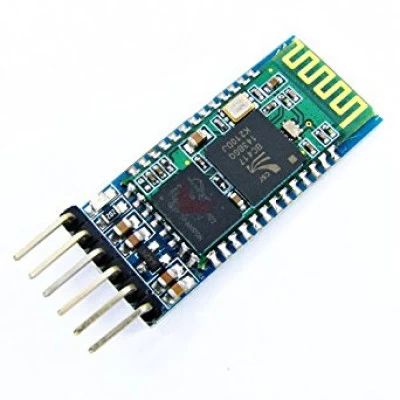Hello and welcome back. In this project, we will learn how to make a 4-in-1 smart robot car using an Arduino Nano board. The four key functions of this robot are Obstacle avoidance, Gesture control, Remote control & Voice control. I have used an ultrasonic sensor to detect obstacles and an HC05 Bluetooth module for Bluetooth communication. Additionally, I used the L293D motor driver IC to control the gear motors, making it a 2WD smart robot. Also, I’ve added an SG90 servo motor that rotates the sensor left and right to scan the surroundings, allowing the robot to detect obstacles in different directions. You can choose any suitable servo motor as you like, but the SG90 works well for this project. If you want to learn how to operate these components individually, please refer to our previous tutorials.

OK, let’s do this project step by step. The required components are given below.

Arduino Nano board x 1 — BUY NOW

HC-05 Bluetooth module x 1 — BUY NOW
L293D motor driver IC x 1

IC base x 1 — BUY NOW

5mm LED x 2 — BUY NOW
100-ohm Resistor x 2
Male header x 1

Barrel jack socket x 1 — BUY NOW
![]()
5V Passive Buzzer - Buy Now
DIP slide switch x 1
Two-pin terminal x 2
Female header x 2

Gear motor x 2 — BUY NOW

65mm Robot wheel x 2 — BUY NOW

Caster wheel x 1 — BUY NOW

Lithium Battery (3.7V) x 2 - BUY NOW

Lithium Battery Holder x 2 - BUY NOW
![]()
Ultrasonic Sensor - Buy Now
![]()
Servo Motor (SG90) - BUY NOW
Jumper-Wires - Buy Now
Step 1
Firstly, identify these components.
Next, position the components on the PCB and solder them individually.


Step 2
Now, connect the wheels to the motors and install them on the chassis. I used double-sided tape for this.

Step 3
Afterward, install the caster wheel on the back side of the chassis.
Next, connect the gear motors to the two-pin terminals.

Step 4
Now, install the servo motor on the front side of the chassis. Afterward, calibrate the servo motor using the PWM servo motor driver.

Step 5
Next, install the ultrasonic sensor on the servo horn and connect it to the PCB using jumper wires. Afterward, connect the servo motor, L293D IC, and Arduino Nano board to the chassis PCB.

Step 6
Now, install the battery holder and connect it to the DC barrel jack. Then, connect the Arduino board to the computer.


Step 7
OK now copy and paste the following program to the Arduino IDE.
Step 8
Next, remove the USB cable and insert the batteries into the battery holder. Then, power on the robot. Finally, you can test the robot using obstacles. If the servo motor doesn’t reach the correct positions, adjust the angles as needed.

Step 9
Now, let’s try the Bluetooth remote control, gesture control, and voice control modes. To do this, power off the robot and reconnect the Arduino board to the computer. If the Bluetooth module is connected, please remove it. Then, comment out the obstacle function and uncomment the Bluetooth control function in the previous code.

Next, remove the USB cable and connect the Bluetooth module to the PCB. Then, power on the car and download the app from the Play Store. Now, run the app and open the Bluetooth control remotes. Now, click the gear wheel icon and find your device. At this point, you have to enable location and location permission. Then select your Bluetooth module. Finally, you will see the green indicator on the screen.
Afterward, you can try the gesture and voice control modes. To do this, click the arrow drop-down button and select the mode. At this point, also connect your car to the remote. Enjoy the project! The full video guide is below. We hope to see you in the next project. Have a great day!
Troubleshooting Tips
Check all connections.Check the Bluetooth connection.Check the motor directions. If they don’t rotate correctly, please swap the wires.Calibrate the servo motor properly. If it doesn’t reach the correct positions, adjust the degrees as needed.Update the app to the latest version.Check the power sources.Check the status of hardware components.

/*Bluetooth control and Obstacle avoidance car with Arduino Nano
Home Page
*/
#include <Servo.h>
Servo servo;
int Spoint = 75; //servo center point
int Lvalue;
int Rvalue;
int dis;
int count = 0;
long duration;
int obstacleCount = 0;
#define ENA 5
#define ENB 6
#define IN1 7
#define IN2 8
#define IN3 9
#define IN4 10
#define LED1 11
#define LED2 12
#define Buzzer 13
#define trig A1
#define echo A0
#define Speed 180
void setup() {
Serial.begin(9600);
pinMode(IN1, OUTPUT);
pinMode(IN2, OUTPUT);
pinMode(IN3, OUTPUT);
pinMode(IN4, OUTPUT);
pinMode(LED1, OUTPUT);
pinMode(LED2, OUTPUT);
pinMode(Buzzer, OUTPUT);
pinMode(trig, OUTPUT);
pinMode(echo, INPUT);
servo.attach(3);//define servo pin
servo.write(Spoint);//servo motor start point
delay(2000);
start();
}
void loop() {
//obstacle ();
//bluetoothControl();
}
//ultrasonic sensor readings
int distance () {
digitalWrite(trig, LOW);
delayMicroseconds(4);
digitalWrite(trig, HIGH);
delayMicroseconds(10);
digitalWrite(trig, LOW);
int t = pulseIn(echo, HIGH);//input pulse and save it veriable
int cm = t / 29 / 2; //time convert distance
return cm;
}
void obstacle () {
dis = distance ();
if (dis <= 9) {
Stop();
Backward();
delay(50);
Stop();
Lvalue = leftsee();
Serial.println(Lvalue);
Rvalue = rightsee();
Serial.println(Rvalue);
if (Lvalue < Rvalue) {
Right();
delay(300);
Stop();
} else if (Lvalue > Rvalue) {
Left();
delay(300);
Stop();
}
} else {
Forward();
}
}
void bluetoothControl(){
if (Serial.available() > 0) {
char value = Serial.read();
Serial.println(value);
if (value == 'U') {
Forward();
} else if (value == 'D') {
Backward();
} else if (value == 'S') {
Stop();
} else if (value == 'L') {
Left();
} else if (value == 'R') {
Right();
} else if (value == '1') {
digitalWrite(LED1, HIGH);
digitalWrite(LED2, HIGH);
} else if (value == '2') {
digitalWrite(LED1, LOW);
digitalWrite(LED2, LOW);
} else if(value == '3'){
digitalWrite(Buzzer, HIGH);
} else if(value == '4'){
digitalWrite(Buzzer, LOW);
}
}
}
void Forward() {
analogWrite(ENA, Speed);
analogWrite(ENB, Speed);
digitalWrite(IN1, HIGH);
digitalWrite(IN2, LOW);
digitalWrite(IN3, HIGH);
digitalWrite(IN4, LOW);
}
void Backward() {
analogWrite(ENA, Speed);
analogWrite(ENB, Speed);
digitalWrite(IN1, LOW);
digitalWrite(IN2, HIGH);
digitalWrite(IN3, LOW);
digitalWrite(IN4, HIGH);
}
void Stop() {
digitalWrite(IN1, LOW);
digitalWrite(IN2, LOW);
digitalWrite(IN3, LOW);
digitalWrite(IN4, LOW);
}
void Left() {
analogWrite(ENA, Speed);
analogWrite(ENB, Speed);
digitalWrite(IN1, HIGH);
digitalWrite(IN2, LOW);
digitalWrite(IN3, LOW);
digitalWrite(IN4, HIGH);
}
void Right() {
analogWrite(ENA, Speed);
analogWrite(ENB, Speed);
digitalWrite(IN1, LOW);
digitalWrite(IN2, HIGH);
digitalWrite(IN3, HIGH);
digitalWrite(IN4, LOW);
}
void start() {
servo.write(0);
delay(500);
servo.write(180);
delay(500);
for (byte a = 0; a < 5; a++) {
servo.write(50);
delay(100);
servo.write(110);
delay(100);
}
servo.write(Spoint);
}
int leftsee() {
servo.write(150);
dis = distance ();
delay(1000);
return dis;
}
int rightsee() {
servo.write(30);
dis = distance ();
delay(1000);
servo.write(Spoint);
return dis;
}










